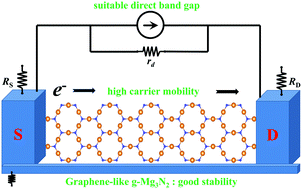A graphene-like Mg3N2 monolayer: high stability, desirable direct band gap and promising carrier mobility†
Abstract
Based on density functional calculations and a global particle-swarm optimization method, a novel Mg3N2 monolayer (g-Mg3N2) with a hexagonal lattice was firstly predicted, displaying an intrinsic direct band gap of 1.86 eV, close to that (1.90 eV) of a MoS2 monolayer. In the infinite planar geometry, each N atom adopts sp2 hybridization with three Mg atoms and each Mg atom as a 2-fold coordinated “bridge” enables the stable bonding with two N atoms. Such a g-Mg3N2 sheet is not only dynamically stable, but also can withstand temperatures up to 2000 K. Importantly, the intrinsic acoustic-phonon-limited carrier mobility of the g-Mg3N2 sheet can reach ∼103 cm2 V−1 s−1 for electrons and ∼433 cm2 V−1 s−1 for holes under ambient conditions, higher than that (60–200 cm2 V−1 s−1) of MoS2 and comparable to that (∼103 cm2 V−1 s−1) of few-layer phosphorene. In particular, the derivative nanotubes have direct band gaps, independent of chirality and radius. The versatility of g-Mg3N2 and its derivatives is expected to possess a broad range of applications in FET devices.



 Please wait while we load your content...
Please wait while we load your content...